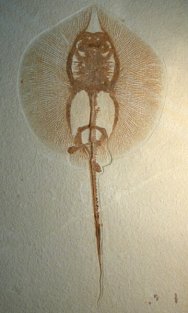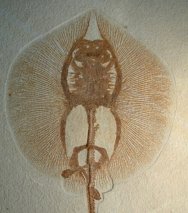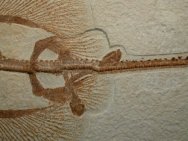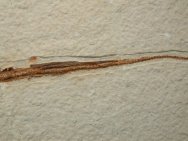|  Description:
This 50 million year old, Eocene-Era fossil fish comes from one
of the world's famous Laggerstatten, the Green River Formation in
Wyoming. A small portion of the fish fossils from Green River exhibit
such fine preservation. The significant extent of soft-tissue preservation
that makes the site famous is evident in this specimen. Description:
This 50 million year old, Eocene-Era fossil fish comes from one
of the world's famous Laggerstatten, the Green River Formation in
Wyoming. A small portion of the fish fossils from Green River exhibit
such fine preservation. The significant extent of soft-tissue preservation
that makes the site famous is evident in this specimen.
This
is an exquisite, museum quality male Stingray specimen known as
Heliobatis radians (Order: Rajiformes; Family: Dasyatidae), at once
a rare and highly sought species, and the only species of ray from
this formation. The preservation is superb and the preparation is
the best there is. Note in the pictures the details in the barbs
and the thorn-like spines of the tail. This one is known to be a
male due to the presence of claspers used by the male in mating.
Heliobatis is highly sought not only for the rarity, but because
a specimen such as this makes for an awesome display.
|
Click
the above picture for a large image; smaller pictures are
below |
Rays
belong to the Chondrichtyes, as do the sharks. All have an inner
skeleton made of cartilage. Since cartilage comprises more organic
material (collagen and elastic tissues) than bone, it decays more
rapidly. As a result, fossils of cartilaginous fishes generally
are rare.
About
the Green River Formation: There are numerous locations worldwide
that are noted for wondrous preservation of bony fishes, and the
Green River formation that covers some 25,000 square miles of SW
Wyoming, west Colorado and east Utah is one of the premier examples.
The formation is one of the largest lacustrine sedimentary accumulations
in the world, and spans the period from 40 to 50 million years ago
during the Eocene Epoch.
During
the Eocene, based on the fossil record, the region was sub-tropical
to temperate. Some 60 vertebrate taxa have been described from the
formation, including crocodiles, boa constrictors, and birds, as
well as abundant invertebrates and plants. The unusually excellent
preservation of the Green River fish fossils is usually attributed
to a combination of two factors: 1) a cold period during the Eocene
that would have caused dead fish to sink faster due to a less inflated
swim bladder; and 2) the great depth of the lakes and the consequent
anoxic conditions that would have often prevented scavengers from
disturbing the carcasses.
| 




